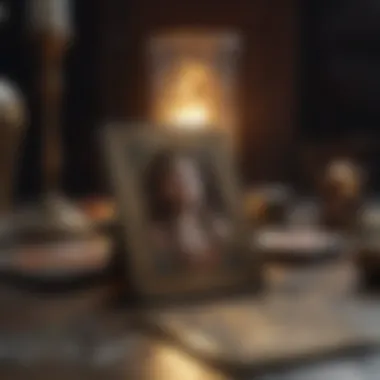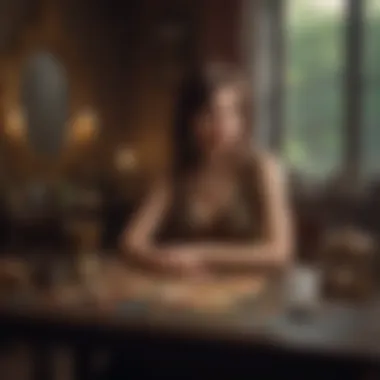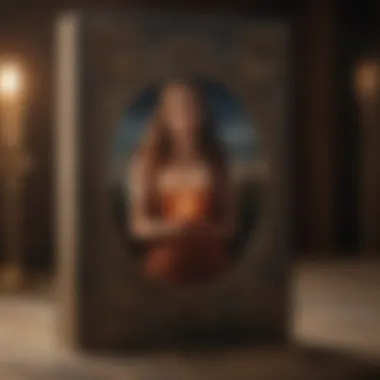One Card Tarot Questions: Discovering Personal Insights


Intro
One card tarot readings offer a profound simplicity in the complex world of tarot. This method allows individuals to seek clarity on specific questions or situations, making it an approachable entry point for both novices and seasoned practitioners. In these readings, the focus often lies not only in the card drawn but also in the quality of the question posed.
This article will unravel the layers that comprise effective one card tarot questions. We will delve into the methodologies of preparing for a reading, how to formulate impactful questions, and the interpretations associated with various tarot cards. The intention is to foster personal introspection and informed decision-making through enhanced tarot reading experiences. By the end, readers will gain insights into the philosophical underpinnings of tarot and practical guidance to avoid common pitfalls.
Zodiac Sign Overview
General Traits
Each zodiac sign carries distinct characteristics that can inform decisions when engaging with tarot. Understanding these traits allows practitioners to tailor their questions based on their innate qualities. For instance, an Aries might seek bold and direct questions, while a Pisces may dwell on deeper emotional inquiries.
Element and Modality
The elements—Fire, Earth, Air, and Water—coupled with modalities—Cardinal, Fixed, and Mutable—offer additional layers to how we interpret tarot readings. For example, a Capricorn’s Earth element may focus on practical solutions, enhancing interpretations in readings centered around career or financial matters.
Strengths and Weaknesses
Awareness of strengths and weaknesses associated with each zodiac sign can guide one card readings. A Leo's confidence may encourage them to ask assertive questions, while a Virgo's analytical nature may ask for clarity in complex situations. Understanding these nuances enriches the tarot experience and leads to more personal insights.
Detailed Horoscope Analysis
Daily Horoscope Breakdown
Connecting daily horoscopes to one card tarot readings can create a routine practice of reflection. Daily insights can help align personal situations with the guidance of tarot cards, promoting a daily check on one’s emotional and mental state.
Weekly and Monthly Predictions
Longer-term predictions offer additional layers for interpretation. When engaging with one card readings, consider how weekly or monthly horoscopes impact the inquiries posed. This broader context can provide deeper insight and foresight for immediate decision-making.
Key Planetary Influences
Planetary movements play a crucial role in astrological readings. They can significantly shape the energies at play during a one card tarot session. Recognizing these influences helps practitioners calibrate their questions to align with cosmic conditions.
Astrology for Personal Growth
Understanding Birth Charts
A birth chart provides a personalized map of cosmic influences. Learners can use their birth chart to guide their questions and card interpretations, ensuring that readings resonate closely with their personal history and current circumstances.
Tips for Embracing One's Zodiac Traits
Adopting practices that focus on embracing astrology can enhance personal growth and decision-making. When using one card readings, consider how one’s inherent traits can shine through. Actively using these traits in your questions can lead to more insightful tarot outcomes.
Astrological Practices to Enhance Life
Incorporating astrological practices alongside tarot can significantly enrich the experience. Consider methods like journaling or meditation that focus on your zodiac influences, enabling a more profound connection when posing one card questions.
The depth of tarot is often found in the quality of questions asked. A thoughtful inquiry can unlock significant insights.
By understanding the interplay between astrology and tarot, readers can develop more impactful, meaningful, and personal one card readings, leading to enriched insights into their life situations.
Understanding One Card Tarot Readings
Understanding one card tarot readings is essential for anyone interested in the practice. This method offers straightforward access to tarot's depth. It can provide insight into personal experiences and decisions, so it is an invaluable tool for both beginners and experienced readers.


Definition of One Card Tarot Reading
A one card tarot reading involves drawing a single card from a tarot deck. This card serves as the focal point for the reading. The simplicity of this approach allows for clear insights without overwhelming complexity. In essence, it distills the vast meanings of tarot into a manageable format, making it approachable for those who may feel daunted by more intricate spreads. A one card reading asks the reader to contemplate the singular message that emerges from that card.
Significance in Tarot Practices
One card tarot readings are not just a simplified version of larger spreads. They carry unique significance within tarot practices.
- Focused Insight: With only one card, the interpretation is direct. It encourages readers to delve deeper into that specific message.
- Accessibility: This method is inviting for newcomers to tarot, effectively lowering barriers to entry.
- Quick Reflection: Many practitioners use one card readings as a daily ritual. It fosters ongoing self-reflection, allowing for quick yet meaningful check-ins.
- Flexibility: This method can be used in various contexts—whether for personal guidance, clarity on a situation, or to address specific inquiries.
The Philosophy Behind Tarot
The philosophy underpinning tarot serves as a fundamental cornerstone for understanding its practices and applications. At its core, tarot embodies layers of symbolism, intuition, and personal reflection. By diving into these philosophical aspects, one can better grasp how tarot extends beyond mere fortune-telling to become a profound tool for self-discovery and insight.
Historical Context of Tarot
The history of tarot is rich and complex, tracing back to the 15th century in Europe. Originally, tarot cards were created for games, notably a card game called tarocchi. However, by the 18th century, the significance of tarot evolved. Writers and scholars began to ascribe mystical meanings to the cards, linking them with ancient symbolism, the Kabbalah, and astrology. This transformation facilitated a shift in viewpoint, where tarot was no longer just a game but a tool for divination and introspection.
Historical tarot decks, such as the Visconti-Sforza, reveal insights about societal norms and beliefs of their times. As tarot spread across different cultures, unique interpretations emerged, influencing today's practices. This historical context is essential for understanding how tarot became intertwined with spirituality and self-exploration.
Modern Interpretations of Tarot
In contemporary settings, tarot is often viewed through various lenses. Many interpret tarot as a psychological tool, reflecting the subconscious and facilitating personal growth. Modern tarot practitioners emphasize the importance of intuition and the personal relationship one develops with their deck. The meanings of individual cards can vary based on the reader's insights and the querent's circumstances.
Numerous styles and decks have emerged, each bringing a distinct perspective and theme. For instance, the Rider-Waite-Smith deck is popularly utilized for its accessibility and straightforward imagery, while the Thoth tarot deck presents a more complex and esoteric approach.
Readers today often incorporate elements like mindfulness and meditation into their practices, viewing tarot as a means for reflection rather than prediction. This modern adaptation connects easily with individuals seeking clarity in their chaotic lives, fostering a sense of empowerment through self-guided inquiry.
Tarot is not just about cards; it represents a dialogue with oneself, a sacred space for reflection and growth.
The philosophy behind tarot encapsulates a historical depth and a modern adaptability. Both elements coalesce to enhance the reading experience, making tarot a versatile tool that resonates with diverse audiences and needs. By understanding this philosophy, one can appreciate the richness that one card readings offer.
Preparing for a One Card Tarot Reading
Preparing for a one card tarot reading is essential for effectively utilizing this practice. It ensures that the reading experience is meaningful and insightful. A thoughtful preparation process not only enhances the reader's focus but also aligns the mind and spirit with the purpose of the inquiry. This preparation includes setting a clear intent, creating a conducive environment, and selecting the appropriate tarot deck. Engaging in these elements creates a more profound connection with the card drawn, allowing for deeper interpretations and insights.
Setting the Intent
Setting the intent is a foundational aspect of any tarot reading, especially with one card. The intent acts as a guiding compass for the session. It directs the energy and concentration of both the reader and the querent towards a specific inquiry or situation. This requires reflection on what one genuinely seeks to understand or discover. A well-articulated intent can range from seeking clarity on personal relationships to contemplating career choices. The intent should be framed as a question or a theme, avoiding vague or overly broad concepts.
Components of a Suitable Environment
A suitable environment plays a pivotal role in a successful tarot session. Consider the following components:
- Quiet Space: Find a location free from distractions, such as noise and interruptions.
- Comfort: Ensure comfort in seating or positioning. A relaxed body promotes a tranquil mind.
- Ambiance: Soft lighting and elements of nature can enhance the atmosphere. Candles or incense may create a calming presence. Creating this environment helps in focusing attention, thus facilitating a more focused reading experience.
Choosing the Right Deck
Selecting the right tarot deck is a critical part of preparation. Each tarot deck has its unique symbolism and artwork, which resonate differently with various individuals. Here are some considerations:
- Familiarity: Choose a deck that feels comfortable and resonates with your energy. It’s important to connect with the imagery.
- Art Style: Consider the art style that appeals to you. This can influence your interpretations and feelings during the reading.
- Understanding of Symbols: A deck that you can relate to and understand easily will likely offer more insightful readings. Picking a deck that aligns with your purpose and personality contributes to a more engaging and intuitive session.
Formulating Effective Questions
Formulating questions effectively is a cornerstone of successful one card tarot readings. A well-framed question can lead to clearer insights and more focused interpretations. This section explores the specific elements that constitute good questions and the benefits that arise from thoughtful inquiry. It is crucial to understand that tarot is a tool for introspection and guidance, thus, the quality of the questions will determine the depth of insight you will receive.
Characteristics of Good Questions


Good questions are clear, specific, and open-ended. They provide direction while allowing for a broad range of interpretations. Here are some essential characteristics to consider:
- Clarity: Avoid vague or ambiguous phrasing. A clear question makes it easier to receive a meaningful response.
- Specificity: Focus on a particular aspect of your life. For instance, instead of asking, “What about my future?”, try, “What should I focus on in my career this year?”
- Openness: Formulate questions that do not lead to a yes or no answer. Open-ended questions encourage a more nuanced interpretation.
- Personal Relevance: Tailor your questions to your own experiences rather than generic inquiries. This form of personalization increases the connection between the card drawn and your current situation.
Interpreting the Card
Interpreting the card is a crucial aspect of one card tarot readings. Understanding the significance of the card can unveil important insights related to one's question or intention. Each card carries its own energy and message. This section focuses on the basic meanings of the cards, as well as how context can influence their interpretation.
Basic Card Meanings
Every tarot deck contains a unique set of cards, each representing different concepts, emotions, and events. Here are some fundamental interpretations for the major arcana:
- The Fool: New beginnings, spontaneity, and potential.
- The Magician: Manifestation, resourcefulness, and power.
- The High Priestess: Intuition, mystery, and the subconscious mind.
- The Empress: Nurturance, femininity, and abundance.
- The Emperor: Authority, structure, and control.
For the minor arcana:
- Cups: Emotions and relationships.
- Wands: Creativity and action.
- Swords: Intellect and conflict.
- Pentacles: Material aspects and stability.
Knowing these basic meanings helps build a foundation for deeper understanding.
Contextual Interpretations
Interpreting a tarot card also involves considering the context of the question and the surrounding energies. A card's meaning can shift depending on what is being asked.
For example:
- If The Lovers appears when asking about a career, it might suggest a need for balance between personal and work life.
- If The Tower shows up in a reading focused on a relationship, it could signify unexpected changes or revelations.
It is vitally important to remain open to how the specific question shapes the card’s message. Personal experience and intuition also play a role in this interpretive process.
“The meaning of a card is not fixed; it evolves with the inquiry's context.”
Common Pitfalls to Avoid
Understanding the common pitfalls in one card tarot readings is crucial for both beginners and seasoned practitioners. It greatly affects the quality and clarity of readings. By being aware of these pitfalls, readers can enhance their interpretations and make more meaningful connections with the guidance tarot offers.
Overly Broad Questions
One of the most prevalent pitfalls is asking overly broad questions. When a question lacks focus, it often yields vague responses. For instance, asking, "What is my future?" does not provide specific insights. Such questions can feel overwhelming and may lead to confusion rather than clarity.
Instead, practitioners should aim for targeted inquiries. A question like, "What energy should I embrace today?" invites deeper contemplation. Specific questions help in channeling interpretation and receiving more actionable guidance. Fostering a clear intention behind the question is essential.
Ignoring Card Reversals
Card reversals can provide significant depth to readings, yet many practitioners overlook them. Ignoring reversals may lead to a one-dimensional understanding of the card’s message. Each card carries its meanings when upright and reversed, offering a wide spectrum of insights.
For example, the upright card of The Lovers often signals harmony, while reverses can suggest imbalance or difficult choices. Being attentive to reversals enriches the interpretative process and provides a nuanced perspective. It’s vital to integrate both aspects in readings to gain a fuller picture of the card's energy.
Disregarding Intuitive Insights
Another critical error is disregarding intuitive insights during readings. While traditional interpretations of tarot cards provide a framework, personal intuition can offer personalized insights that are equally valuable. Ignoring this inner voice can result in missing significant layers of meaning.
For instance, a practitioner may pull the Ace of Cups, which generally represents new emotional beginnings. However, their intuition might guide them to connect it with an unresolved past issue. Recognizing and trusting these insights can deepen the reading experience.
Practical Examples


Practical examples serve as a fundamental aspect of understanding one card tarot readings. They allow individuals to see how theory translates into actionable insights. By examining sample reading scenarios and decoding different cards in context, readers can grasp the intricacies of tarot practice more effectively. This section presents clear illustrations that can enhance comprehension and guide users in their personal journeys.
Sample Reading Scenarios
In this subsection, we explore various scenarios where one card readings can provide significant insights. Each example demonstrates how context and intent affect the interpretation of a card.
- Scenario 1: Career Guidance
A person wonders about their current job situation. They draw the Six of Pentacles. This card symbolizes generosity and sharing. The interpretation may indicate a need to seek support from colleagues or reconsider the balance of giving and taking in the work environment. - Scenario 2: Relationship Clarity
Someone seeks understanding about their romantic relationship and pulls the Two of Cups. This card represents partnership and harmony. The insight might reveal the potential for deeper connections and mutual support in the partnership. - Scenario 3: Personal Growth
A seeker is interested in exploring their internal struggles. They draw the Eight of Swords. This card suggests feelings of restriction and self-imposed limitation. The interpretation may lead to reflecting on personal fears and the steps needed to overcome them.
These scenarios illustrate how a single card can unearth layers of meaning relevant to specific life contexts, making one card readings practical tools for self-reflection.
Decoding Different Cards in Context
Understanding the context surrounding the drawn card is essential for accurate interpretations. Different meanings can emerge based on the question asked and the specific situation of the seeker. Let’s take a look at a few examples to illustrate this.
- The Fool
Typically associated with new beginnings, the Fool can signify a leap of faith if drawn while asking about a significant life change. However, if the question concerns a risky decision, the Fool could serve as a caution regarding impulsive actions. - The Tower
This card often represents sudden upheaval and chaos. In the context of a question about a stable relationship, it may indicate a necessary ending or transformation. But when paired with a question about career advancement, it may warn about unexpected challenges that could emerge. - The Star
Symbolizing hope and renewal, the Star provides a positive outlook when drawn amid difficult circumstances. In the context of health, it can imply healing and recovery. When asking about creative projects, it may suggest inspiration and clarity.
By examining how different cards interact with specific scenarios, readers can refine their interpretative skills and enhance their overall tarot reading experience.
Incorporating One Card Readings into Daily Life
Utilizing one card tarot readings in daily life can serve as a profound tool for personal development and decision-making. By emphasizing the importance of these readings, individuals gain a structured approach to self-reflection. The simplicity of drawing just one card offers a focused lens through which to examine one's thoughts and feelings. Additionally, integrating this practice into a daily routine fosters mindfulness, encouraging a deeper connection with life's complexities.
Reflection and Personal Growth
One card readings provide an excellent opportunity for reflection and personal growth. When individuals engage with a card, they are invited to explore their current mindset and emotional state. Each card carries its own meanings and associations. By reflecting on these meanings, practitioners can gain insights into their behaviors, desires, and challenges.
This process often uncovers hidden patterns and motivating factors in one's life. For example, drawing The Hermit might inspire a need for introspection, urging the reader to withdraw temporarily from the chaos of daily life. Conversely, drawing The Sun might signify a moment to celebrate accomplishments and embrace positivity. Overall, regularly practicing these readings enhances self-awareness and encourages individuals to assess their growth.
- Daily Reflection: Set aside time each day to interpret the card drawn.
- Journal Insights: Keep a journal of your reflections on each card for future reference.
- Revisit Past Readings: Periodically revisit cards drawn to evaluate changes in perspective.
Using Tarot for Decision-Making
Integrating tarot into decision-making processes can be particularly effective. One card readings provide clarity when confronted with choices, especially when emotions cloud judgment. Such readings serve as a practical way to examine options from various angles. By posing specific questions and drawing a card, readers can cultivate a clearer understanding of each potential outcome.
For example, you may ask, “What should I focus on today?” A card drawn in response can shine light on what truly deserves your attention. This technique does not guarantee answers but rather opens avenues for thought, allowing individuals to weigh their decisions more thoughtfully.
- Enhanced Clarity: Draw a card when faced with dilemmas to clarify options.
- Dissolve Overthinking: Use the reading to break cycles of uncertainty and analysis paralysis.
- Align Choices with Values: Reflect on whether the implications of a decision resonate with one’s personal values.
Incorporating one card readings into daily life enhances not only personal insights but also the decision-making process. Engaging with tarot daily nourishes the understanding of oneself and fosters intuitive growth.
Epilogue
The conclusion of this article serves as a vital synthesis of the insights explored throughout the discussion on one card tarot questions. It is essential to recognize the transformative potential of utilizing these readings in both personal and broader contexts. This section summarizes how one card readings empower individuals to delve deeper into their own consciousness and experiences.
Recap of Key Insights
Reflecting on the core themes discussed in preceding sections, it’s clear that one card tarot readings are not just simple divination tools. They are vehicles for profound introspection. Readers gain clarity on how to formulate precise questions that elicit meaningful engagement with the cards. Additionally, we explored the significance of creating a conducive environment for one's readings, the implications of card interpretations, and the importance of intuitive insights.
A few vital takeaways include:
- Effective questioning enhances the depth of readings.
- Contextual interpretations are crucial for accurate insights.
- Avoiding common pitfalls helps maintain the integrity of the reading process.
These insights collectively reinforce that one card tarot readings can significantly enhance personal growth and decision-making.
Encouragement for Further Exploration
As we conclude, it is important to encourage readers to continue their exploration of tarot as a tool for self-discovery. Engaging with one card readings can foster a deeper relationship with intuition and personal insight, opening pathways to greater understanding.
Delve into different tarot decks to find one that resonates with you. Experiment with various questions and interpretations.
Furthermore, readers should not hesitate to seek communities, whether on platforms like Reddit or Facebook, where they can share experiences and learn from others. As tarot is a vast field, ongoing study and practice will enhance one’s skills and confidence.
In summary, the journey with tarot does not end here. Each reading invites a fresh exploration of life’s complexities.







